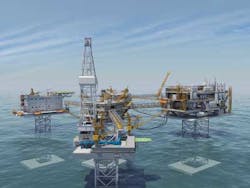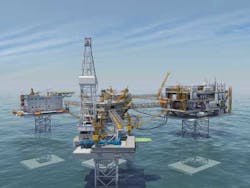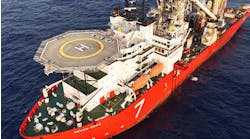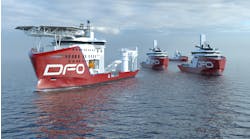Sarah Parker Musarra
Editor
At a time when most offshore companies are rapidly trying to streamline operations and shed extraneous costs, Blue Capital Pte. Ltd. (Singapore) chairman and CEO Brian Chang collaborated with rig designer Peter William Nimmo to develop the mobile mono column platform (MCP), a design Chang refers to as one that is "back to basics."
"We reassembled existing, proven technologies in a pragmatic manner to create offshore real estate," Chang said. "While other rigs might look similar to the MCP, these do not use the same components."
The MCP prototype is designed to monetize fields in less than 500 ft (152 m) of water as quickly as possible, he said.
Design
Mat-supported jackups have been an industry standard for decades; the Society of Petroleum Engineers says that a forerunner to the traditional jackup as it is now known first appeared around the mid-1950s. But the prototype MCP, financed through Blue Capital's subsidiary Calm Oceans Pte. Ltd. (COPL), offers a unit vastly different than the traditional spudcan. It can operate on a soft seafloor without punch-through risk, COPL says. Additionally, no pre-loading is required.
Supported on a single leg, the MCP jackup unit consists of a deck box mounted on a four-chord square truss structure on a mat foundation, the latter of which can be jacked up during decommissioning to allow for more easy relocation. The high-payload MCP can maintain a higher variable deck load during transit than the limited variable deck load offered with conventional jackup units. The MCP prototype, namedCalm Ocean 101, can support a topsides payload of 5,000 metric tons (5,511 tons) and hold wet load up to 6,500 metric tons (7,165 tons), with future units capable of being tailored to customers' needs. The unit can also be situated upon a seabed sloped up to 2°.
Uses
TheCalm Ocean 101 rig is designed to provide companies valuable offshore real estate in waters up to 500 ft (152 m), allowing them to access and monetize the marginal fields whose potential profits might have previously eluded them. These fields, smaller and isolated from the main, primary field and its infrastructure, are conventionally deemed not economically valuable or too risky to develop. Of course, economic viability is up for discussion and liable to reset upon every drop in oil price. However, ideal conditions for the prototype MCP are field developments in the early stages of production, in mid-level water depths – including and especially marginal fields.
Australia, the Philippines, China, Indonesia, Vietnam, Malaysia, India, Gabon, and Congo were places Chang said the company had looked at to deploy the MCP, noting that it was found to be suitable in those field conditions. He called the unit "very flexible, economical and financially feasible for marginal field developer," pointing out that unlike a jacket, construction vessels are not required to install or uninstall the MCP.
"Construction vessels are expensive to hire and increase project risks, making many marginal field developments unviable. Calm Oceans is offering to lease our MCP unit," he explained. "Oil companies chartering the MCP do not have to be concerned with high capex associated with jacket and jacket installation."
The multi-purpose prototype platform, which features a square deck, has a maximum space of 4,225 sq m (45,478 sq ft), which the company says is almost 60% more than the deck offerings of conventional jackup rigs. This deck can be left bare for storage space, or it can also be customized with a number of individual or a combination of modular facilities. These modules – which include accommodation, a multi-purpose facility, drilling and/or production, and production support – allow the MCP to transition from storage space to work space.
It is this flexible, modular customization that will enable the MCP to bring fields into production quicker and suffer from minimal downtime, the company believes. COPL says that once oil is recovered, customers using the jacket-less MCP can skip immediately to first oil: No jacket front-end engineering and design stage, no subsequent fabrication, mobilization, and installation.
Topsides equipment can be switched out over its 25-year design life. "Depending on complexity of the topside modules, we may be able to uninstall/install modules offshore or send the rig back to the yard for modifications," Chang said.
It is also scaleable. The prototype can be made to client specifications, or multiple MCPs can be deployed to one project, configured for different activities or to scale up variable deck load capacity.
Chang, founder of Yantai Raffles (now CIMC Raffles) and Promet (now PPL Shipyard), has acquired more than 40 years' industry experience in a career that began with jackup construction pioneers FELS (now KFELS). Nimmo, his partner on the design, spent his early career with Bethlehem Steel Corp. and Baker Marine Engineers Inc. before providing engineering services for companies such as Transocean Offshore and Noble-Denton, as it was known then.
Calm Ocean 101 is being built on speculation under ABS' mobile offshore unit class in China, and Chang explained that he expected to keep construction in the current yard unless there are local content requirements from the contract.
"Construction is relatively straight forward and we expect the majority of the yards to be capable of constructing the MCP. We can supply a kit, which includes the license, basic design, jacking system and leg materials," he said. In February, a successful jacking test was completed.
Announced at Houston's Offshore Technology Conference 2014, the unit is scheduled for a 2Q 2015 delivery. At its OTC 2014 unveiling, it was said to be the first in a series of MCPs.
Editor's note: additional reporting by Robin Dupre





